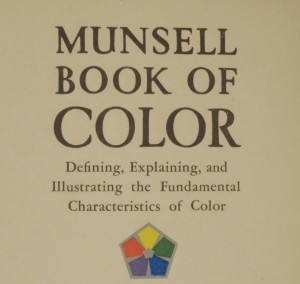
Color systems and methods of describing and classifying color date back hundreds of years. Chevreul, the pioneer in this field, although he did excellent work, did not influence the practical users of color because his color classification was based arbitrarily on the irregularities of dye and pigment mixture, which are very difficult to retain in one’s memory. Only a method of color notation that is simple to understand and easy to remember can adequately fill the practical needs of present day color users.
The great scientist, Helmholtz, gave considerable thought to this question. He stated that color possesses three simple attributes or dimensions, which are determined directly by the eye, and which have no direct relation to dye or pigment mixtures. As he did not have the opportunity to illustrate just how these three dimensions were to be visualized, however, nor what standards should be set up for developing a general color language, his work remained for a time buried in the archives of science.
In the late nineties, it occurred to an instructor of art, Mr. Albert H. Munsell, to utilize the possibilities opened up by Helmholtz in practical color study. Mr. Munsell decided that the best way to bring about a popular understanding of this subject was to illustrate the three dimensions of color graphically on a color sphere. He therefore planned a series of color charts presenting carefully standardized scales of HUE, VALUE, and CHROMA.
Seven years of study and experimentation finally made possible his first color chart, which appeared in 1905. This chart was accompanied by a text book describing the simple basis on which this and the succeeding charts were to be built, and suggesting the application of the proposed language of color to the field of art education. Eight more years of patient work resulted in the completion of fifteen standard color charts, which in 1913 were assembled in the “Atlas of the Munsell Color System.” This useful piece of work immediately aroused widespread interest.
By 1913, the strain of carrying on not only the specifications of these color charts, but the presentation of this subject to audiences both in this country and abroad, in addition to his regular duties at Massachusetts School of Art, showed itself in the weakening of an unusually robust constitution, and in a protracted period of invalidism which finally resulted in Mr. Munsell’s death in 1918.
Shortly before his death, Mr. Munsell expressed the hope that the work to which he had dedicated his life world be carried on for the benefit of future generations. The Munsell Color Company was formed for this purpose, and for the past eight years it has been engaged in the work of restandardizing and improving the color charts along the line foreseen by their originator. The “Munsell Book of Color,” which is the successor to “The Atlas of the Munsell Color System,” combines practical teaching experiences, derived from the field of art education, with the rigorous investigation of scientists from the time of Helmboltz down to the present day.
It is a pleasant duty to make acknowledgement to those persons in art education and in industry whose advice and interest have played an important part in making this publication simple, usable, and accurate. Their comments and suggestions, based on an intimate knowledge of the practical side of the question, have been collected over a period of many years, in order that they might be cast in the tangible form found in this volume. We are particularly indebted to Mr. F.G. Cooper, free-lance artist, and illustrator for “Life,” who has enriched this book with his “Foreward” and with his lucid article on “Color,” to Mr. Royal Bailey Farnum, Director of the Massachusetts School of Art, and to Mr. James C. Boudreau, Direct of the School of Fine and Applied Arts, Pratt Institute, for their suggestions on the educational aspects of this subject; and to Mr. M. Rea Paul, Director of the Research Laboratories of the National Lead Company, for his comments on industrial applications.
We are indebted to the United States Bureau of Standards, and in particular to Mr. Irwin G. Priest, Director of Colorimetry Section, for facilities, cooperation, and advice in color standardization.
In making acknowledgement of the many forms of advice and encouragement which we have received, we are keenly aware that a considerable part of it has been accorded us in memory of the originator of this Color Notation, who was esteemed by all who knew him.
A.E.O. MUNSELL
Baltimore, Md.
August, 1929
Read other excerpts from The 1929 Munsell Book of Color
The Munsell Book of Color: Foreward by F.G. Cooper



Leave a Reply